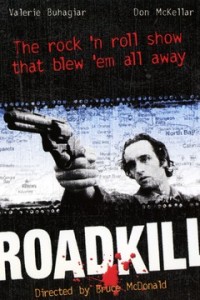Roadkill was an underrated 1989 Canadian film by Bruce McDonald that was called “an increasingly weird mix of Heart of Darkness and The Wizard of Oz.”
 And about a girl who learns to drive.
And about a girl who learns to drive.
There are some food safety aspects to roadkill.
According to Manny Alvarez of Fox News, in 2017, Wisconsin saw nearly 20,000 deer-caused vehicle accidents, according to the Wisconsin Department of Transportation. These accidents usually peak in May, June, October and November, when deer mating and birthing seasons occur?
Wisconsin allows people to register their car-killed deer, bear or turkey online or by phone. Once confirmed, the animal can be removed and used as food without even waiting for a police-issued tag.
But Wisconsin isn’t the only state friendly to roadkill cuisine.
According to The Guardian, over 600 moose are killed in Alaska each year, leaving meat on the road that tallies to thousands of pounds. Rather than wasting it, the state gives the roadkill to charities willing to process and use the animals at their own risk.
Other states that allow roadkill pickups are Washington, Oregon, Idaho and Tennessee. According to the NY Daily News, California is also trying to legalize this practice, which may be further spurred on by the cost of disposing of car-killed animals.
One study by the UCDavis Road Ecology Center counted about 6,600 roadkill instances in California during its study period. These accidents led to an estimated $307 million in expenses for the state, and estimates go as high as $600 million when factoring in accidents unreported to police.
By these numbers, the stakes appear high for officials deciding what to do with road-killed animals. Allowing drivers and bystanders to take the roadkill home seems an easy solution. In fact, the practice has many supporters high up in the ranks.
The PETA website states, “If people must eat animal carcasses, roadkill is a superior option to the neatly shrink-wrapped plastic packages of meat in the supermarket.
“Eating roadkill is healthier for the consumer than meat laden with antibiotics, hormones, and growth stimulants, as most meat is today.”
Gawd.
But there are those nasty bacteria to consider, so roadkill, like any raw product, should be handled with care.





 the roughly 13,154 kilograms of frozen turkey carcasses to be re-introduced into the food chain.
the roughly 13,154 kilograms of frozen turkey carcasses to be re-introduced into the food chain..jpeg) he had eaten some of the turkeys and no one got sick," Akerstream said.
he had eaten some of the turkeys and no one got sick," Akerstream said. So says Dave Barker, who works for the Knights of Columbus in Grand Falls-Windsor, Newfoundland.
So says Dave Barker, who works for the Knights of Columbus in Grand Falls-Windsor, Newfoundland. "It depends on how much moose is actually destroyed in the accident, but normally you get at least two moose burger sales out of one moose, so you’re looking at anywhere from $2,500 to $3,000," said Shane Budgell, president of the Lions Club in Grand Falls-Windsor.
"It depends on how much moose is actually destroyed in the accident, but normally you get at least two moose burger sales out of one moose, so you’re looking at anywhere from $2,500 to $3,000," said Shane Budgell, president of the Lions Club in Grand Falls-Windsor. I’m always open to trying new foods, but I don’t know if I’m all that interested in eating squirrel. Sure they’re terribly cute with their little hands and bright eyes, but I can’t help but wonder what kinds of diseases they carry. In terms of food I’ve always thought squirrel was more of a roadkill dish.
I’m always open to trying new foods, but I don’t know if I’m all that interested in eating squirrel. Sure they’re terribly cute with their little hands and bright eyes, but I can’t help but wonder what kinds of diseases they carry. In terms of food I’ve always thought squirrel was more of a roadkill dish..jpg) “The situation is more than simply a matter of having too many squirrels. In fact, there is a war raging in Squirreltown: invading interlopers (gray squirrels introduced from North America over the past century or more) are crowding out a British icon, the indigenous red squirrel immortalized by Beatrix Potter and cherished by generations since. The grays take over the reds’ habitat, eat voraciously and harbor a virus named squirrel parapox (harmless to humans) that does not harm grays but can devastate reds. (Reports indicate, though, that the reds are developing resistance.)
“The situation is more than simply a matter of having too many squirrels. In fact, there is a war raging in Squirreltown: invading interlopers (gray squirrels introduced from North America over the past century or more) are crowding out a British icon, the indigenous red squirrel immortalized by Beatrix Potter and cherished by generations since. The grays take over the reds’ habitat, eat voraciously and harbor a virus named squirrel parapox (harmless to humans) that does not harm grays but can devastate reds. (Reports indicate, though, that the reds are developing resistance.) “If you want to grab your shotgun, make sure you have very good aim — squirrels must be shot in the head; a body shot renders them impossible to skin or eat. (You want to get rid of the head in any event, as squirrel brains have been linked to variant Creutzfeldt-Jakob disease, the human form of
“If you want to grab your shotgun, make sure you have very good aim — squirrels must be shot in the head; a body shot renders them impossible to skin or eat. (You want to get rid of the head in any event, as squirrel brains have been linked to variant Creutzfeldt-Jakob disease, the human form of  The Boston Globe
The Boston Globe Town manager Joseph M. Zeneski said Villatico began selling lobsters from a refrigerated truck behind his restaurant, and the restaurant reportedly offered $19.99 lobster specials. Police found crates of lobster inside the restaurant and plucked lobsters from boiling pots as evidence, the Worcester Telegram & Gazette reported.
Town manager Joseph M. Zeneski said Villatico began selling lobsters from a refrigerated truck behind his restaurant, and the restaurant reportedly offered $19.99 lobster specials. Police found crates of lobster inside the restaurant and plucked lobsters from boiling pots as evidence, the Worcester Telegram & Gazette reported.